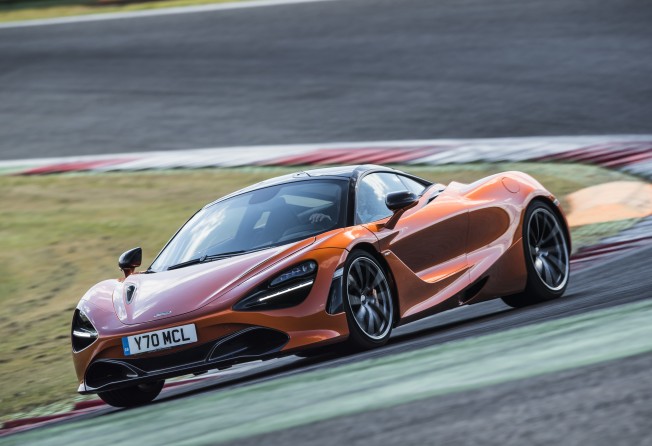
China’s young tech millionaires just the right demographic for British supercar maker McLaren as it zips past rivals
- Sales of the British supercar maker soared 125 per cent last year in China; Hong Kong was the seventh best market
- Youngest McClaren buyers in their early 20s

Last year was disappointing to say the least about the mass car market in China. Sales declined 2.8 per cent – the first drop since the early 1990s – as an escalating trade war and slowing economy preyed on ordinary consumers.
But unlike the turmoil in the mass market segment, sales of supercars tore through the roof, despite the stock market rout in China that erased hundreds of billions of dollars in wealth of the country’s super-rich.
Three of the big marques – Lamborghini, Ferrari and McLaren – had a stellar year in China. But it was McClaren that stood head and shoulders above the rest, with a massive sales jump of 125 per cent year on year to 330 units. Lamborghini and Ferrari each saw a 12.6 per cent rise.
Globally, however, Lamborghini sold 5,750 cars in 2018 – 51 per cent more year on year. Ferrari sold 9,251 cars, up 10.2 per cent, while McClaren boosted its numbers by 44 per cent.
“China is interesting in that we have had such strong growth in the last year,” George Biggs, managing director for Asia-Pacific at McLaren Automotive, told the South China Morning Post on Monday, at the unveiling of its Hong Kong partner Adamas Motors’ upgraded showroom in Hopewell Centre.

In Hong Kong, sales more than doubled, to 58 units in 2018, making it McLaren’s number seven market overall.
Prices of McLaren cars start from £140,000 (US$184,000) for the entry level Sport Series, going up to £1 million for a limited edition Senna series.
Biggs is confident that economic fluctuations and trade war talk will not impact McLaren too much, though he doubts that the carmaker can double sales again in China in 2019.
“We are expecting a good year this year,” said Biggs, adding that his buyer segment is “isolated” from economic turbulence.

The surge in 2018 was welcome news after McLaren’s China sales fell in 2017 to 147 units, from 228 the previous year.
Weakness in the sterling may also have helped. From April 17 to December 11, 2018, the pound dropped 13 per cent against the Hong Kong dollar.
In 2017, McLaren suffered a loss of £65 million on a turnover of £871 million. The automotive business accounted for 70 per cent of group revenue, and the F1 division 24 per cent. As of the third quarter of 2018, McLaren already had revenue of £847 million.
Biggs said the Chinese are “by far, the youngest” buyers of any market, with the youngest in their early 20s and the average buyer in their early 30s.
By contrast, in new markets such as Indonesia and the Philippines buyers were making their first purchase of a McLaren, as opposed to mature markets such as Japan and Hong Kong, where they were switching to the marque much later, said Biggs.

The latest Knight Frank Wealth Report offers good news for the supercar market.
The number of ultra high net worth individuals (people with US$30 million in assets or more) are set to grow rapidly in China, India, Vietnam and Indonesia in the next five years.
McLaren’s marketing focuses on its engineering and association with its F1 team, which appeals to a tech oriented audience of boyish multimillionaires.
“We are very strong in California and in southern China [both of which are tech hubs],” Biggs said. The Hong Kong showroom even features a live feed direct from McLaren’s space-age looking production facility in Woking, United Kingdom.
Adamas Motors’ 5,000 square foot facility is in addition to 12 McLaren showrooms in China, the country with the second highest number of showrooms after the US with 21, and ahead of the UK and Japan, with eight and five respectively.

McLaren Automotive began operations in 2010 and in 2011 reported revenue of just under £70 million. In 2017, McLaren Automotive founder Ron Dennis sold his shares in the company, and the automotive brand and F1 team were organised under the McLaren Group.
In 2018, Canadian businessman Michael Latifi paid £204 million to become a 10 per cent shareholder in the McLaren Group, according to a BBC report. Mumtalakat, the sovereign wealth fund of Bahrain, owns about 55 per cent of group, a stake it bought in 2007.
In 2018, McLaren announced its Track 25 set of objectives, an aggressive set of targets that includes a £1.2 billion investment in R&D and launching a suite of new models.
According to Biggs, the factory at Woking can produce a maximum of 6,000 cars per year, adding that there was no intention to expand that number further, possibly to keep the aftermarket in McLaren cars boosted.
Should Brexit proceed in a messy way on March 29, it is likely the sterling could suffer a considerable fall, giving McClaren a turbo boost and allowing it to reach its maximum production capacity within no time.